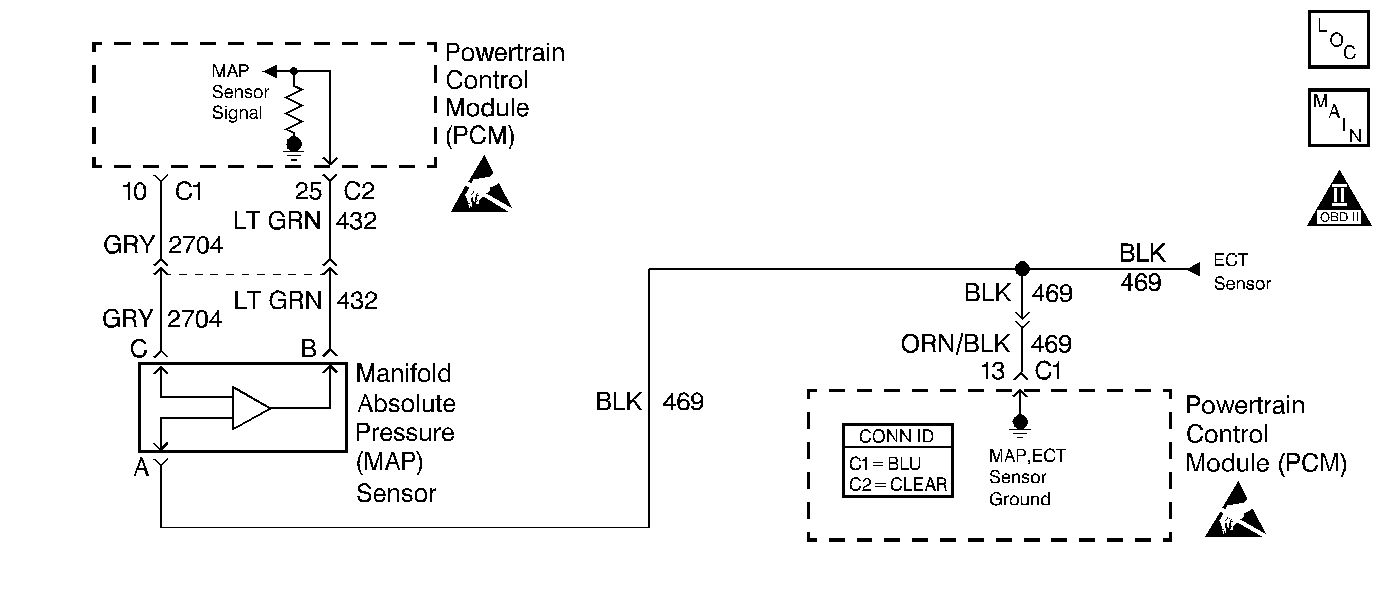
Circuit Description
The Manifold Absolute Pressure (MAP) sensor responds to changes in intake manifold pressure (vacuum). The MAP sensor signal voltage to the PCM varies from below 2 volts at idle (high vacuum) to above 4 volts with the key ON, engine not running or at wide open throttle (low vacuum).
The MAP sensor is used to determine manifold pressure changes while the EGR flow test diagnostic is being run (refer to DTC P0401 Exhaust Gas Recirculation (EGR) Flow Insufficient ), to determine engine vacuum level for some other diagnostics and to determine barometric pressure (BARO). The PCM monitors the MAP signals for voltages outside the normal range of the MAP sensor. If the PCM detects a MAP signal voltage that is excessively low, DTC P0107 will be set.
Conditions for Running the DTC
| • | No TP sensor DTCs present. |
| • | Engine running. |
| • | System voltage greater than 9.0 volts. |
| • | Throttle angle above 10%, if engine speed is above 1000 RPM. |
Conditions for Setting the DTC
| • | The MAP sensor signal is less than 12.1 kPa. |
| • | The above conditions have been met for greater than 2 seconds. |
Action Taken When the DTC Sets
| • | The PCM illuminates the malfunction indicator lamp (MIL) on the second consecutive ignition cycle that the diagnostic runs and fails. |
| • | The PCM records the operating conditions at the time the diagnostic fails. The first time the diagnostic fails, the PCM stores this information in the Failure Records. If the diagnostic reports a failure on the second consecutive ignition cycle, the PCM records the operating conditions at the time of the failure. |
| • | The PCM writes the conditions to the Freeze Frame and updates the Failure Records. |
Conditions for Clearing the MIL/DTC
| • | The PCM will turn OFF the malfunction indicator lamp (MIL) during the third consecutive trip in which the diagnostic has run and passed. |
| • | The history DTC will clear after 40 consecutive warm-up cycles have occurred without a malfunction. |
| • | The DTC can be cleared by using a scan tool. |
Diagnostic Aids
Check for the following conditions:
| • | Monitor the MAP sensor using the scan tool. If the MAP sensor does not respond to throttle changes, check the 3X reference circuits from the ignition control module to the PCM. |
| • | If the 3X reference signal is lost the PCM will only update the MAP sensor reading once per key cycle, when the engine is first started. |
| • | Depending on where the MAP sensor voltage (high voltage or low voltage) is when the engine is started, the high or low voltage MAP sensor DTCs will set. |
Important: : Remove any debris from the connector surfaces before servicing a component. Inspect the connector gaskets when diagnosing or replacing a component. Ensure that the gaskets are installed correctly. The gaskets prevent contaminate intrusion.
| • | Poor terminal connection. |
| Inspect the harness connectors for backed out terminals, improper mating, broken locks, improperly formed or damaged terminals, and faulty terminal to wire connection. Use a corresponding mating terminal to test for proper tension. Refer to Intermittents and Poor Connections Diagnosis , and Connector Repairs Wiring Systems. |
| • | Damaged harness. |
| Inspect the wiring harness for damage. If the harness appears to be OK, observe the sensor display on the scan tool while moving connectors and wiring harnesses related to the sensor. A change in the sensor display may indicate the location of the fault. Refer to Wiring Repairs in Wiring Systems. |
| • | Inspect the PCM and the engine grounds for clean and secure connections. |
If the DTC is determined to be intermittent, reviewing the Fail Records can be useful in determining when the DTC was last set.
Step | Action | Value(s) | Yes | No |
|---|---|---|---|---|
1 | Was the Powertrain OBD System Check performed? | -- | ||
2 |
Is MAP value near the specified value? | 0.0 volt | ||
3 |
Does scan tool indicate DTC P0107 failed? | -- | Go to Diagnostic Aids | |
4 |
Is MAP value near the specified value? | 4.95V | ||
5 |
Is MAP value near the specified value? | 4.95V | ||
6 |
Was the 5 volt reference A circuit open or shorted to ground? | -- | ||
7 | Test the 5 volt reference A circuit for a poor connection at the PCM and replace terminal if necessary. Refer to Testing for Continuity , Intermittents and Poor Connections Diagnosis , Repairing Connector Terminals , and Connector Repairs . Did the terminal require replacement? | -- | ||
8 |
Was the MAP signal circuit open or shorted to ground? | -- | ||
9 | Test the MAP sensor signal circuit for a poor connection at the PCM and replace terminal if necessary. Refer to Testing for Continuity , Intermittents and Poor Connections Diagnosis , Repairing Connector Terminals , and Connector Repairs . Did the terminal require replacement? | -- | ||
10 | Replace the MAP sensor. Refer to Manifold Absolute Pressure Sensor Replacement . Is the action complete? | -- | -- | |
11 |
Important: : Replacement PCM must be programmed. Refer to Powertrain Control Module Replacement/Programming . Replace the PCM. Is the action complete? | -- | -- | |
12 |
Does scan tool indicate DTC P0107 failed? | -- | System OK |
